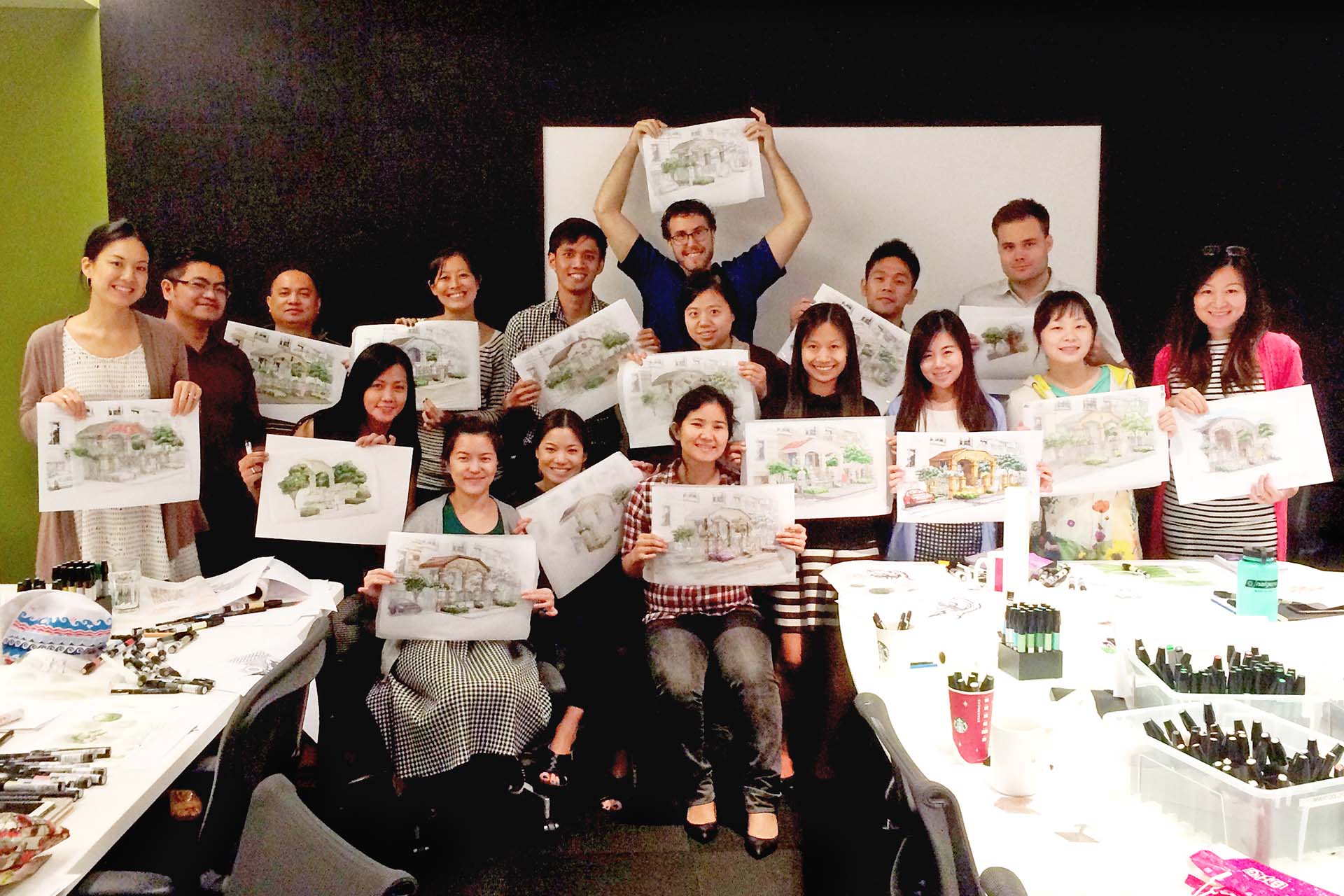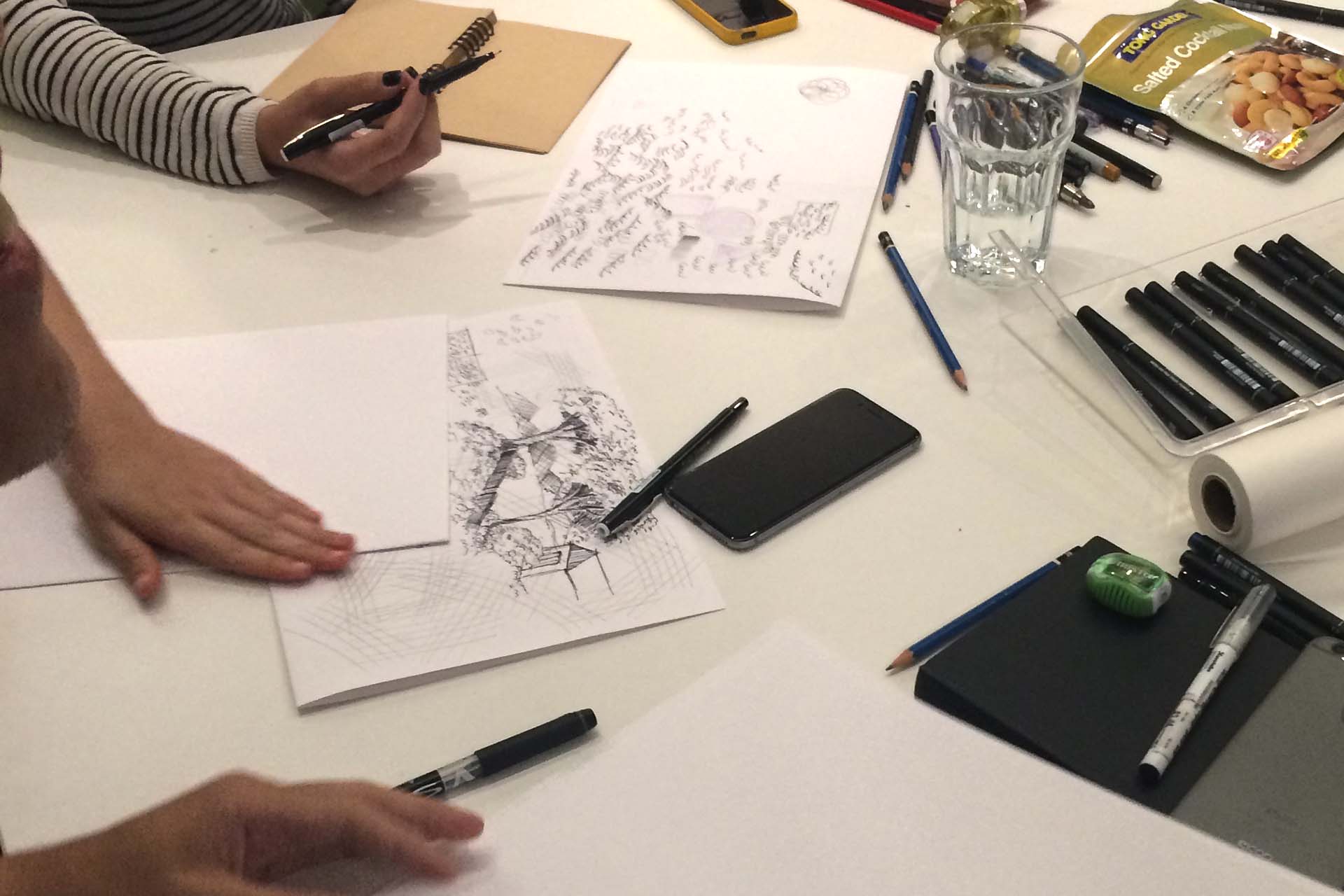The WATG Singapore Sketching Workshop
By WATG
March 30, 2015
It astonishes me that even when you are in an architectural firm with a lot of very creative people (Yes, WATG included), it’s always these three words that I hear most: “I can’t Draw!” It is very rare indeed when somebody says “Why, yes, I draw quite well, actually.”
And yet, being able to draw is on the top of the wish list of most creative people and designers. We were brought up thinking that we can’t draw, that we must be born with talent, and when we attempt to draw something it just doesn’t look “right.” Most of us think that its better just to do it in the computer where there is always an “undo” or “delete” button when something goes wrong.
And I get that.

It pays for architects and designers like us to know how to sketch properly.
It totally boils down to confidence. Because most can draw or sketch, but not to the point where they’re comfortable enough to show to other people. In addition, they may have spent so much time conceptualizing in a computer that sketching with pen on paper has become foreign (and uncomfortable) to them.
But sketching is a skill and not some god-given talent. And like any other skill, like learning Revit or Lumion, it requires a lot of effort and time, and the commitment to learn and improve.
And contrary to popular belief, Sketching does not require artistic talent, it just takes practice…lots of it. Sure it helps if you‘re talented, but it is not a prerequisite. You are not creating a masterpiece, you are just jotting down an idea or putting out a design in physical form, albeit in its most infant form. A complex sketch is made up of mainly lines and curves. The curves tend to be circles and arcs (portions of a circle). But the most important thing to know before you start sketching is to actually understand whether you are really interested in the subject. You have to feel excitement and joy once a pen or pencil is in your hand. There may even be times when only your love for sketching will keep you going through rough days.
The actual lectures were minimized and more time was focused on actual exercises.
It pays for architects and designers like us to know how to sketch properly. Because we always communicate in a graphical language. We sketch constantly, whether it is to show others our ideas and concepts while brainstorming or trying to help non-architects (clients) visualize a design concept. But we also have to make sure that our sketches are good enough to be understood. In design discussions, it is very helpful to translate a problem and its solution into a sketch instead of trying to write a mathematical equation required to solve the problem.
For the last two days here in Singapore, together with senior associate Evelyn Ang, we did a sketching and coloring workshop in the office which saw a combined participation of about 35 people. There were two segments where the staff could attend either one (but are encouraged to attend both). The first covered “The Fundamentals of Sketching” and the second was “Reyndering with Markers.” We made sure that the workshop touched basic and relevant information that they can readily apply to their day-to-day work, with direct and easy to understand tips and guidelines. The actual lectures were minimized and more time was focused on actual exercises. We kept everything simple and straightforward so that in the end, the attendees could walk away with a basic but important base of knowledge and applicable skill while having a lot of fun doing it (not to mention feeling a bit “high” because of the strong scent of Chartpak Markers used by everyone).

Many thanks to all the attendees. I hope they all build on what they learn and will try to sketch more. And even the ones who have not attended the workshop can still be better. Carry a sketchbook wherever you go and sketch whenever you have time to do so. There’s nothing too little or too insignificant when it comes to sketching, whether you’re just drawing a door knob detail or sketching the Capitol. That’s the beauty of sketching, desire and willingness precedes talent. And every sketch will make you better…and make you feel better.
Latest Insights
Perspectives, trends, news.

- News |
- Trends
Interior Design Trends 2025: Emotional, Experiential, and Environmentally Conscious Spaces

- News |
- Trends
Interior Design Trends 2025: Emotional, Experiential, and Environmentally Conscious Spaces

- Strategy & Research |
- Trends
2025 Outlook: WATG Advisory predicts the top hospitality trends.

- Strategy & Research |
- Trends
2025 Outlook: WATG Advisory predicts the top hospitality trends.

- Employee Feature
Unlocking Value & Vision: Guy Cooke & Rob Sykes Discuss WATG Advisory’s Bespoke Approach

- Employee Feature
Unlocking Value & Vision: Guy Cooke & Rob Sykes Discuss WATG Advisory’s Bespoke Approach

- Case Study |
- Design Thinking & Innovation
In Conversation: Marcel Damen, General Manager of Rissai Valley, a Ritz-Carlton Reserve

- Case Study |
- Design Thinking & Innovation
